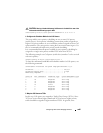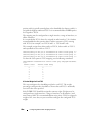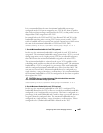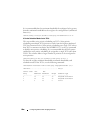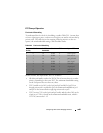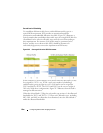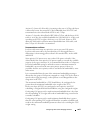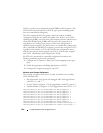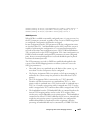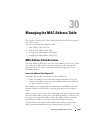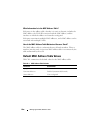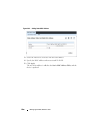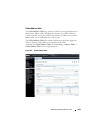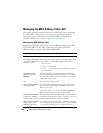
Configuring Data Center Bridging Features 1013
console(config-if-Te1/0/1)#classofservice traffic-class-group 2 2
console(config-if-Te1/0/1)#traffic-class-group weight 30 70 0
console(config-if-Te1/0/1)#traffic-class-group strict 2
N4000 Operation
When DCBx is enabled on manually configured ports, it is not necessary for
the ETS parameters to match, regardless of the version of DCBX negotiated
or configured. Configuration mismatches are logged.
In auto configuration mode, ETS parameters from the configuration source
are checked (Max TCs 3 and bandwidth equal to 100%) and if the system is
capable of performing the configuration, it is accepted and propagated as
received to the other auto-configuration ports. The ETS Recommendation
TLVs are preferred over the ETS Configuration TLVs. Auto-configuration via
DCBX overrides manually configured ETS parameters for auto-configured
ports, however, manual configuration is restored should the port be placed
back into the manual port role.
The ETS parameters received via DCBX are modified and applied to the
system via the DCBX Mapping function as follows (references are to the
802.1Qaz parameters):
• Like traffic classes are combined up to the limits of the system; e.g., no
more than 2 lossless CoS queues may be configured.
• The Priority Assignment Table (user priority to CoS queue mapping) is
utilized by the system to map user priorities to the traffic classes (CoS
queues).
• The TSA Assignment Table is converted to use 3 TCGs internally.
Priorities with like characteristics are combined into TCGs, i.e. strict
priority traffic is combined into a TCG, lossless traffic is combined into a
TCG, etc. Generally, strict priority traffic is mapped onto TCG 2, lossless
traffic is mapped onto TCG1 and best effort traffic is mapped onto TCG0.
• The bandwidths from the TC Bandwidth Table are summed based on the
internal TCG mapping and are used to set the TCG weights. Other
switches may assign bandwidth to strict priority queues. This bandwidth is
counted in the sum to ETS 100% validation check, however, internally the
weight for strict priority queues is ignored and they are configured for
unlimited bandwidth. An implication of this assignment is that the
percentage of bandwidth that may be consumed by a WDRR TCG after



